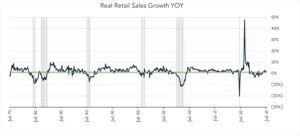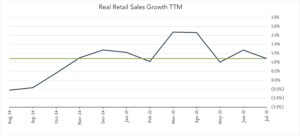August 15, 2025
July Retail Sales - Another Broad Advance; June Revised Higher
In nominal terms, U.S. retail sales advanced 3.9% year-over-year and 0.5% month-over-month. Adjusting for inflation, spending advanced 1.2% year-over-year and 0.3% month-over-month. Nominal growth in June was favorably revised from +0.6% to +0.9%. The broad advance implies a healthy start to consumer spending in the second half of the year after uncertainty around trade policy dampened sentiment in the first half. While the labor market appears to be shifting into a lower gear, additional clarity on trade policy and a rebound in the stock market support greater confidence in consumers’ spending power. Fed officials have continued to assess the trajectory of monetary policy opting to keep rates steady until the impact of evolving trade policy is more clear. Investors are pricing in two to three quarter point cuts in 2025 and have ratcheted up odds on a September cut. Policymakers will have the benefit of additional inflation reports and another jobs report before meeting in September.
- Real (inflation adjusted) retail sales advanced 1.2% year-over-year. In July, retail sales grew 3.9% nominally netting real growth of 1.2% after adjusting for 2.7% inflation. Higher spending at brick-and-mortar retailers (+10.6%), online retailers (+8.0%), restaurant dining (+5.6%) and motor vehicles (+4.7%) was partially offset by a declines at the pump (-2.9%). Seven of thirteen categories advanced in real terms.
- Real (inflation adjusted) retail sales advanced 0.3% month-over-month. In July, nominal retail sales levels grew 0.5% compared to June netting real growth of 0.3% after adjusting for 0.2% inflation in the month. Higher spending on motor vehicles (+1.6%) and online (+0.8%) was partially offset by declines at brick and mortar retailers (-1.7%) and restaurants (-0.4%). Nine of thirteen categories advanced in real terms.



